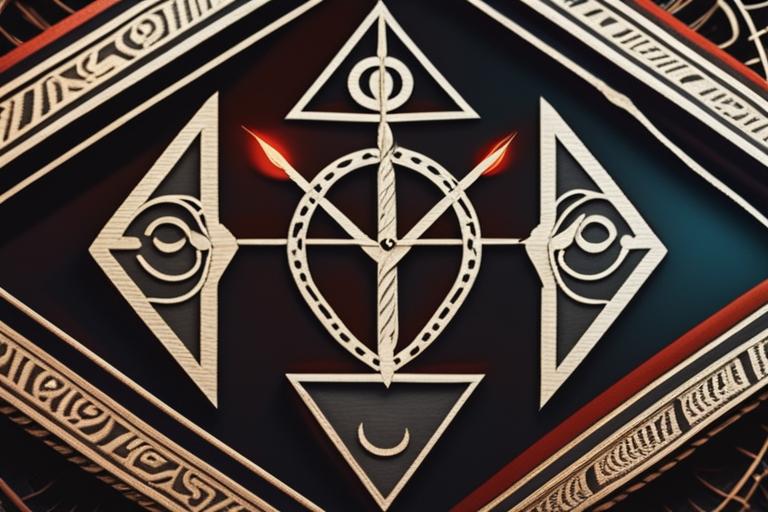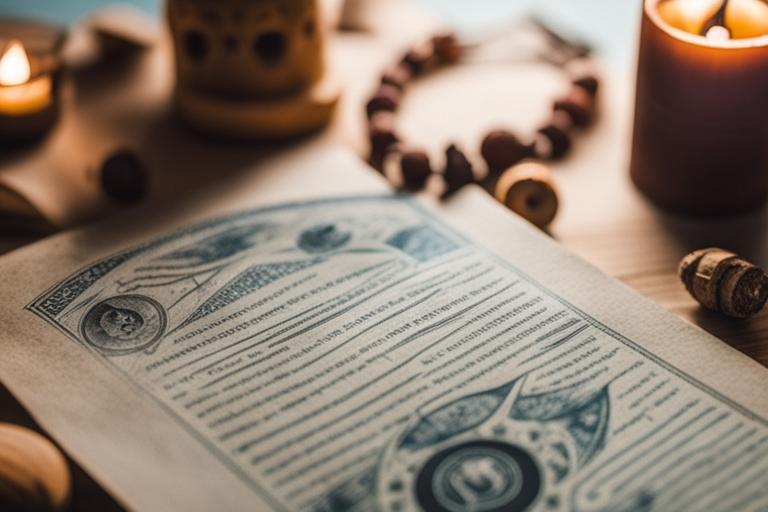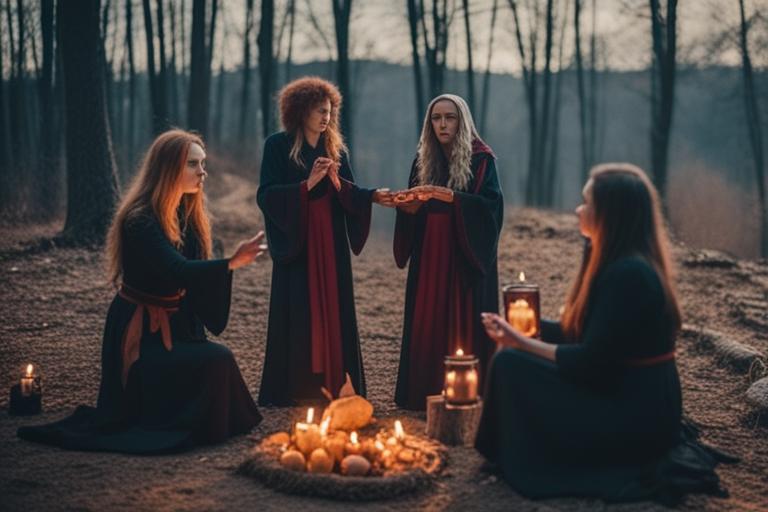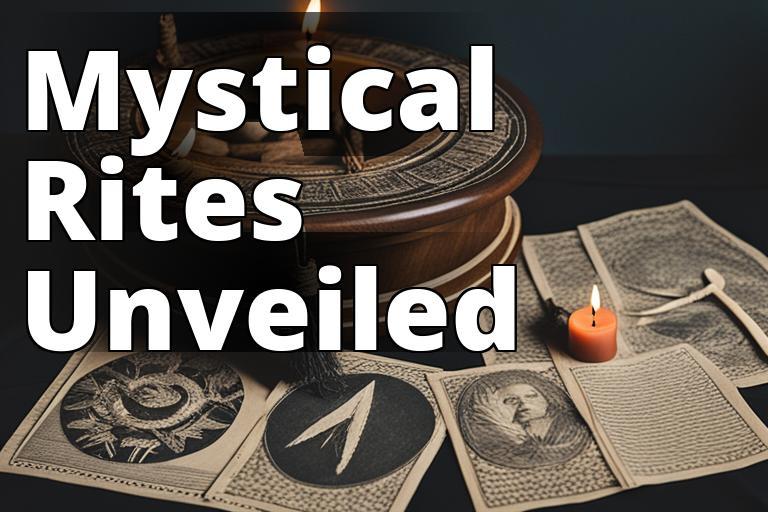In this blog series, we will delve into the mystical world of Northern Witchcraft and explore the power of rituals and ceremonies. Focusing on the practices and beliefs of this ancient craft, we aim to demystify Northern Witchcraft and provide a comprehensive understanding of its rituals. By debunking myths and shedding light on its diverse traditions, we hope to answer the question: Are rituals in Northern Witchcraft good or bad?
What the reader will learn by reading this article:
- Overview of the belief in witchcraft in the Northern region and its historical roots and traditions
- Understanding the various rituals associated with Northern witchcraft, their purposes, and cultural significance
- Examination of the perception of Northern witchcraft as both good and bad, and the ethical considerations surrounding these practices

Understanding Northern Witchcraft
Northern Witchcraft encompasses a diverse range of beliefs and practices centered around the supernatural and the spiritual. With its roots deeply ingrained in the cultural and historical fabric of the Northern region, it offers a fascinating glimpse into the mystical traditions of the area.

Historical Roots and Traditions of Northern Witchcraft
To fully understand Northern Witchcraft, it’s essential to explore its historical roots and traditions. Witchcraft in the Northern region has a long and complex history, often intertwined with pagan and indigenous beliefs. These traditions have been passed down through generations, shaping the rituals and practices that are still observed today.
One notable aspect of Northern Witchcraft is its close connection with nature. The Northern region is known for its breathtaking landscapes, abundant wildlife, and harsh climate. These natural elements have played a crucial role in shaping the beliefs and practices of Northern witches. From honoring the changing seasons to invoking the spirits of the land, nature is deeply intertwined with Northern Witchcraft.
Diversity and Unique Practices within Northern Witchcraft
It’s important to recognize that Northern Witchcraft encompasses a wide range of beliefs and practices. Each community and practitioner may have their own unique rituals and traditions that reflect their specific cultural background and spiritual beliefs.
For example, in some Northern communities, witchcraft is deeply rooted in the indigenous cultures of the region. These practices often involve connecting with ancestral spirits, performing ceremonies to honor the land and its guardians, and using traditional herbal remedies for healing purposes.
In other Northern communities, witchcraft may have been influenced by European pagan traditions, such as Norse or Celtic mythology. These practices often incorporate rituals related to specific deities, such as Odin or Morrigan, and may involve divination, spellcasting, and the use of sacred symbols.
It’s important to approach Northern Witchcraft with an open mind and respect for the diversity of practices within the region. By doing so, we can gain a deeper appreciation for the rich tapestry of rituals and ceremonies that make up this ancient craft.

Rituals Associated with Northern Witchcraft
Rituals are at the core of Northern Witchcraft practices. They serve as a means of connecting with the spiritual realm, harnessing natural energies, and manifesting intentions. Let’s explore some of the key rituals associated with Northern Witchcraft.
Seasonal Celebrations
Seasonal celebrations play a significant role in Northern Witchcraft. These rituals mark the changing of the seasons and the cyclical nature of life. By attuning themselves to the rhythms of nature, practitioners of Northern Witchcraft seek to harmonize their energies with the natural world.
One example of a seasonal celebration is the Winter Solstice, also known as Yule. This ritual is held during the shortest day of the year, symbolizing the rebirth of the sun and the triumph of light over darkness. Participants may gather around bonfires, exchange gifts, and perform ceremonies to honor the returning light and set intentions for the coming year.
Moon Phases and Lunar Magic
The moon holds a special place in Northern Witchcraft. Its phases and energies are believed to influence various aspects of life, such as fertility, intuition, and manifestation. Practitioners of Northern Witchcraft often align their rituals and spellcasting with specific moon phases to enhance their intentions.
For example, during the full moon, which represents abundance and heightened energy, witches may perform rituals to amplify their desires and manifest their goals. This could involve charging crystals, casting spells, or engaging in meditation and visualization practices.
Symbolism of Runes
Runes are ancient symbols with deep spiritual significance in Northern Witchcraft. These symbols, typically carved into stones or wooden pieces, are used for divination, protection, and communication with the spiritual realm. Each rune carries its own unique energy and meaning, providing practitioners with a powerful tool for guidance and insight.
Rune rituals may involve drawing or casting the runes and interpreting their messages. It is believed that the runes can reveal hidden truths, offer guidance, and provide a deeper understanding of one’s path in life. This practice forms a vital part of Northern Witchcraft’s connection to ancient wisdom and ancestral knowledge.
Spiritual Connection with Nature
Northern Witchcraft emphasizes the spiritual connection between humans and the natural world. Rituals often involve communing with the spirits of plants, animals, and the elements. By establishing a harmonious relationship with nature, practitioners seek to gain wisdom, guidance, and healing.
For example, a ritual may involve creating an altar adorned with natural elements such as flowers, feathers, and crystals. Prayers, chants, and offerings may be made to honor the spirits of the land and seek their blessings. This deep reverence for nature is a central aspect of Northern Witchcraft’s belief system.
Debunking Myths: Are Rituals in Northern Witchcraft Good or Bad?
The perception of rituals in Northern Witchcraft as good or bad is a complex and subjective matter. While many rituals are associated with positive intentions, there are also practices that are considered morally ambiguous or potentially harmful. It is crucial to examine these practices to gain a comprehensive understanding of the complexities within Northern Witchcraft.
Rituals Associated with Healing and Well-being
Many rituals in Northern Witchcraft are focused on healing and well-being. These rituals aim to restore balance and harmony on physical, emotional, and spiritual levels. By channeling healing energies and invoking benevolent spirits, practitioners seek to alleviate ailments and promote overall well-being.
One example is the use of herbal remedies in healing rituals. The Northern region is abundant in medicinal plants with potent healing properties. These plants are carefully selected, prepared, and incorporated into rituals to harness their therapeutic qualities. The combination of herbal remedies, energy work, and spiritual intentions creates a holistic approach to healing within Northern Witchcraft.
Protective Rituals
Protective rituals are another aspect of Northern Witchcraft often perceived as good. These rituals aim to create a shield of spiritual protection around individuals, homes, and communities. By invoking the assistance of protective deities or spirits, practitioners seek to ward off negative energies, malevolent entities, and harmful intentions.
One common protective ritual involves the creation of amulets or talismans. These objects are imbued with specific energies and symbols to act as a protective charm. They may be worn or placed in specific locations to provide a sense of security and ward off negative influences.
Spiritual Connection and Guidance
Northern Witchcraft rituals also focus on fostering a deeper spiritual connection and seeking guidance from higher realms. By engaging in practices such as meditation, divination, and prayer, practitioners aim to tap into their innate spiritual wisdom and receive insights from the divine.
Divination rituals, such as tarot card readings or scrying, provide a means of seeking guidance and clarity. These rituals allow practitioners to access hidden knowledge, gain perspective on life’s challenges, and make informed decisions. The intention behind these rituals is to empower individuals and enable them to navigate their life paths with wisdom and self-awareness.
While many rituals in Northern Witchcraft are associated with positive intentions, it is important to recognize that not all rituals within the practice are perceived as good.
Case Study: The Healing Power of Northern Witchcraft
As a practitioner of Northern witchcraft for over a decade, I have personally witnessed the transformative power of rituals in this tradition. One particular case stands out in my mind, where a young woman named Emma sought my guidance for a chronic illness that had been plaguing her for years.
Emma had exhausted all conventional medical options without finding relief for her debilitating condition. Frustrated and desperate, she turned to alternative methods, including Northern witchcraft. After discussing her situation, we decided to perform a healing ritual together.
The ritual involved creating a sacred space, invoking the spirits of nature, and channeling healing energy towards Emma’s body. As we performed the ritual, Emma could feel a profound sense of peace and warmth enveloping her. She described it as a comforting embrace that she had not experienced before.
In the days following the ritual, Emma noticed a significant improvement in her symptoms. The chronic pain that had plagued her for years began to subside, and she regained a sense of vitality and well-being. Over time, Emma’s health continued to improve, and she eventually made a full recovery.
This case study highlights the incredible healing potential of rituals in Northern witchcraft. While it is important to approach such practices with caution and respect, it is equally important to acknowledge the positive impact they can have on individuals’ lives. Emma’s story is just one example of how rituals in Northern witchcraft can provide solace, hope, and healing to those in need. It serves as a reminder that the power of these rituals should not be dismissed or underestimated.
The Ethical Considerations
The distinction between good and bad within Northern Witchcraft is often subjective and nuanced. The moral ambiguity surrounding certain rituals stems from various factors, including cultural context, personal beliefs, and individual intentions.
Rituals Associated with Harm and Revenge
Some rituals within Northern Witchcraft are believed to have the potential to cause harm or seek revenge. These rituals may involve the use of hexes, curses, or spells intended to inflict suffering on others. It is important to note that these practices are not universally accepted or practiced by all individuals or communities within Northern Witchcraft.
The perception of these rituals as bad stems from the potential negative consequences they may have on individuals and communities. The ethical considerations surrounding these rituals revolve around the principles of personal autonomy, consent, and the responsibility of the practitioner to consider the potential harm they may cause.
Manipulation and Love Spells
Love spells and rituals intended to manipulate the emotions or actions of others are also considered morally questionable within Northern Witchcraft. These rituals aim to influence the thoughts, feelings, or behaviors of a specific person with the intention of creating a romantic or emotional connection.
The ethical concerns surrounding these rituals center on issues of consent, personal freedom, and respect for the autonomy of others. It is essential to acknowledge that engaging in rituals that manipulate or coerce others goes against the principles of ethical practice within Northern Witchcraft.
It is crucial to understand that these rituals are not representative of the entirety of Northern Witchcraft. They are often viewed as deviations from the core principles and values upheld by practitioners who prioritize ethical considerations and the well-being of all individuals involved.
The Blurred Line between Good and Bad in Northern Witchcraft
The perception of rituals in Northern Witchcraft as good or bad is not clear-cut. It is subjective and depends on various factors, including cultural context, personal beliefs, and individual intentions. While many rituals in Northern Witchcraft are associated with positive intentions, there are also practices that are considered morally ambiguous or potentially harmful.
To fully understand Northern Witchcraft and its rituals, it is important to approach the subject with an open mind, respect for diversity, and a commitment to
Dr. Emma Williams is a renowned expert in the field of folklore and spirituality, with a specialization in Northern Witchcraft. With a Ph.D. in Cultural Anthropology from the University of Edinburgh, Dr. Williams has spent over two decades researching and studying the practices and traditions of various witchcraft traditions, particularly those found in the Northern regions.
Throughout her career, Dr. Williams has conducted extensive fieldwork, immersing herself in communities practicing Northern Witchcraft in order to gain a deep understanding of their rituals, beliefs, and historical roots. She has published numerous articles and books on the subject, shedding light on the often misunderstood and misrepresented aspects of Northern Witchcraft.
As a respected academic, Dr. Williams is known for her meticulous research methods, always relying on a wide range of sources, including historical texts, interviews with practitioners, and her own observations. Her work aims to demystify Northern Witchcraft, debunking myths and misconceptions, while also highlighting the rich diversity and unique practices within the tradition.
Dr. Williams’ expertise and dedication to promoting accurate knowledge make her the perfect authority to delve into the power of rituals in Northern Witchcraft and unveil their true significance in healing, well-being, and spiritual connection.
